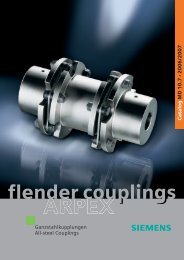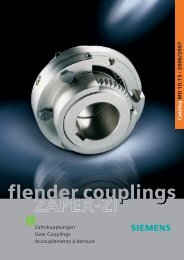You also want an ePaper? Increase the reach of your titles
YUMPU automatically turns print PDFs into web optimized ePapers that Google loves.
������<br />
Strömungskupplungen Fluid Couplings Coupleurs hydrauliques<br />
Baureihen FG / FV FG and FV Series Séries FG / FV<br />
FVD<br />
FGD<br />
FLUDEX-Kupplungen Baureihen FG und FV<br />
Die FLUDEX-Kupplungen der Baureihen FG und<br />
FV sind für den bevorzugten Antrieb über das<br />
Kupplungsgehäuse konzipiert. Bei der Baureihe<br />
FV (Kupplung mit Vorkammer) treibt der Motor<br />
über die elastische N-EUPEX-Kupplung (9) und<br />
die Vorkammer (115) das Kupplungsgehäuse,<br />
bestehend aus Schaufelschale (101) und Deckel<br />
(102), an. Über die Rotationsströmung der Kupplungsfüllung<br />
wird das Schaufelrad (105) und<br />
die abtriebsseitige Hohlwelle angetrieben, die<br />
auf die Getriebe- oder Arbeitsmaschinenwelle<br />
aufgesetzt wird. Bei der Baureihe FG (Grundkupplung)<br />
entfällt die Vorkammer, und die elastische<br />
Kupplung wird direkt an die Schaufelschale<br />
angeflanscht.<br />
Beim Anfahren der Kupplung wird ein Teil der<br />
Ölfüllung in den Stauraum (10) verdrängt. Hierdurch<br />
wird eine Drehmomentbegrenzung beim<br />
Anfahren erreicht. Bei der Baureihe FV nimmt die<br />
Vorkammer einen Teil der Ölfüllung entsprechend<br />
dem Füllstand bei stehender Kupplung auf. Beim<br />
Anfahren ist die wirksame Ölfüllung im Arbeitsraum<br />
(8) um den Betrag der Vorkammerfüllung<br />
verringert, wodurch das Anfahrmoment deutlich<br />
abgesenkt wird. Aus der antriebsseitig angeordneten<br />
Vorkammer wird das Öl über kleine Bohrungen<br />
zeitabhängig in den Arbeitsraum zurückgespeist<br />
und das Kupplungsdrehmoment auch<br />
bei blockiertem Abtrieb angehoben.<br />
Durch diese Nachspeisung kann ein Antrieb mit<br />
sehr geringem Startmoment bei stark entlastetem<br />
Motor sanft angefahren werden; gleichzeitig können<br />
jedoch auch größere Lastmomente durch den<br />
Drehmomentanstieg in der Kupplung überwunden<br />
werden.<br />
Die Eigenschaft der Vorkammerkupplung kann<br />
vorteilhaft unter anderem zum sanften Anfahren<br />
von leeren, teilgefüllten und vollen Gurtförderbändern<br />
ausgenutzt werden.<br />
Kupplungen der Baureihe FG werden für normale<br />
Anfahrmomentbegrenzung, als Anlaufkupplung<br />
zur Schwingungstrennung und als Überlastbegrenzung<br />
im Blockadefall eingesetzt.<br />
FLUDEX-Kupplungen der Baureihen FG und FV<br />
werden in folgenden Bauarten und Größen angeboten:<br />
FGO 370 - 887 Grundkupplung mit Anschluß-<br />
FGD 370 - 887 flansch bzw. mit elastischer<br />
FGE 370 - 565 N-EUPEX-Kupplung<br />
FGM 370 - 755 Bauart D, E oder M<br />
FVO 370 - 887 Vorkammerkupplung mit An-<br />
FVD 370 - 887 schlußflansch bzw. mit<br />
FVE 370 - 565 elastischer N-EUPEX-Kupp-<br />
FVM 370 - 755 lung Bauart D, E oder M<br />
FLUDEX couplings of the FG and FV series<br />
FLUDEX couplings of the FG and FV series are<br />
specially designed for input via the blade wheel<br />
housing. In case of the FV series with delay<br />
chamber, the motor drives the coupling housing<br />
consisting of blade wheel housing (101) and<br />
cover (102) via a flexible N-EUPEX coupling (9)<br />
and the delay chamber (115). The rotational force<br />
of fluid transfers the torque to impeller (105) and<br />
output side hollow shaft assembled to the gear<br />
or driven machine shaft. The FG series (basic<br />
design) has no delay chamber and the flexible<br />
coupling is flange-mounted directly to the blade<br />
wheel housing.<br />
On starting of the coupling, part of the oil filling is<br />
forced into the damming chamber (10) resulting<br />
in torque limitation. In case of the FV series, the<br />
delay chamber (115) takes part of the fluid filling<br />
corresponding to the filling level of a stationary<br />
coupling. On starting, the effective fluid quantity<br />
in the working chamber (8) is reduced by the<br />
amount of fluid in the delay chamber and thus<br />
clearly reducing the starting torque. Fluid from<br />
the delay chamber, located on the input side, is<br />
returned, time-controlled, through small holes<br />
to the working chamber, hereby increasing the<br />
coupling’s torque even with a blocked output<br />
side.<br />
Owing to this replenishing feature, a drive can<br />
be softly started with a very low starting torque<br />
and an almost unloaded motor. At the same<br />
time, increased load torques can be overcome<br />
by the torque increase in the coupling.<br />
The property of the delay chamber coupling<br />
can be used advantageously, for instance, to<br />
soft-start empty, part-loaded and loaded conveyor<br />
belts.<br />
Couplings of the FG series are used for normal<br />
starting torque limitation, as starting couplings<br />
for the purpose of separating vibrations, and for<br />
limiting overloads in the event of a drive blockage.<br />
The following coupling types and sizes of the<br />
FLUDEX FG and FV series are available:<br />
FGO 370 - 887 Basic coupling with<br />
FGD 370 - 887 connecting flange or with<br />
FGE 370 - 565 flexible N-EUPEX coupling<br />
FGM 370 - 755 type D, E or M<br />
FVO 370 - 887 Delay chamber coupling with<br />
FVD 370 - 887 connecting flange or with<br />
FVE 370 - 565 flexible N-EUPEX coupling<br />
FVM 370 - 755 type D, E or M<br />
Gehäuseantrieb / Outer wheel drive<br />
Entraînement par le carter<br />
8 Arbeitsraum / Working chamber / Chambre de travail<br />
9 Elastische Kupplung (N-EUPEX, Bauart D)<br />
Flexible coupling (N-EUPEX, type D)<br />
Accouplement élastique (N-EUPEX, type D)<br />
10 Stauraum / Damming chamber / Chambre de refoulement<br />
101 Schaufelschale (Außenrad)<br />
Blade wheel housing (outer wheel)<br />
Rotor de pompe (roue extérieure)<br />
102 Deckel / Cover / Couvercle<br />
103 Schmelzsicherungsschraube / Fusible safety plug<br />
Bouchon fusible de sûreté<br />
105 Schaufelrad (Innenrad) / Impeller (inner wheel)<br />
Rotor de turbine (roue intérieure)<br />
106 Hohlwelle / Hollow shaft / Arbre creux<br />
115 Vorkammer / Delay chamber / Chambre de retardement<br />
153 Einfüllschraube / Filler plug / Bouchon de remplissage<br />
173 Ablaßschraube (Vorkammer) / Drain plug (delay chamber)<br />
Bouchon (chambre de retardement)<br />
163 Verschlußschraube (Ölablaß) / Screw plug (oil drain)<br />
Bouchon de fermeture (vidange d’huile)<br />
Coupleurs FLUDEX séries FG et FV<br />
Les coupleurs FLUDEX des séries FG et FV sont<br />
conçus spécialement pour l’entraînement par le<br />
carter. Pour les coupleurs avec chambre de retardement,<br />
série FV, le moteur entraîne le carter<br />
composé du rotor de pompe (101) et du couvercle<br />
(102) du coupleur par l’intermédiaire de l’accouplement<br />
élastique (9) et de la chambre de retardement<br />
(115). Le rotor de turbine (105) et l’arbre de<br />
sortie creux monté sur le réducteur ou la machine<br />
entraînée sont entraînés par le courant produit<br />
par la circulation du fluide dans le coupleur. Sur<br />
la série de base FG il n’y a pas de chambre<br />
de retardement et l’accouplement élastique est<br />
monté directement sur le rotor de pompe.<br />
Au démarrage du coupleur une partie du fluide est<br />
précipitée dans la chambre de refoulement (10).<br />
On atteint ainsi une limitation du couple au démarrage.<br />
Pour la série FV avec chambre de retardement,<br />
celle-ci absorbe une partie du fluide correspondant<br />
au niveau de remplissage du coupleur à<br />
l’arrêt. Au démarrage, le niveau du fluide dans la<br />
chambre de travail (8) est diminué de la quantité<br />
du fluide refoulée vers la chambre de retardement,<br />
ce qui a pour effet de baisser considérablement<br />
le couple de démarrage. Le fluide qui se<br />
trouve dans la chambre de retardement à l’entrée<br />
est refoulé au fur et à mesure par de petits trous<br />
dans la chambre de travail et le couple du coupleur<br />
s’elève même en cas de blocage à la sortie.<br />
Cette propriété de remplissage permet de faire<br />
démarrer en douceur un moteur très chargé avec<br />
un couple de démarrage très petit. Il est également<br />
possible de surmonter des couples plus<br />
élevés par l’augmentation du couple de rotation<br />
dans le coupleur.<br />
La propriété du coupleur, avec chambre de retardement,<br />
est son utilisation avantageuse pour le<br />
démarrage en douceur de transporteurs à bandes<br />
à vide, à charge partielle ou à pleine charge.<br />
Les coupleurs de la série FG sont utilisés pour<br />
la limitation normale du couple de démarrage<br />
et permettent d’éviter les vibrations ainsi que<br />
les surcharges en cas de blocage.<br />
Les coupleurs FLUDEX des séries FG et FV<br />
existent dans les types et tailles suivantes:<br />
FGO 370 - 887 coupleur de base avec bride<br />
FGD 370 - 887 de raccordement resp. avec<br />
FGE 370 - 565 accouplement élastique<br />
FGM 370 - 755 N-EUPEX type D, E ou M<br />
FVO 370 - 887 chambre de retardement coup-<br />
FVD 370 - 887 leur avec bride de raccordement<br />
FVE 370 - 565 resp. avec accouplement élas-<br />
FVM 370 - 755 tique N-EUPEX type D, E ou M<br />
6 Flender K 481 � 2006 - 03






